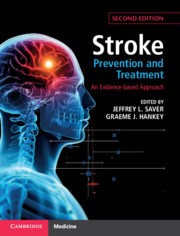Book contents
- Stroke Prevention and Treatment
- Stroke Prevention and Treatment
- Copyright page
- Dedication
- Contents
- Contributors
- Preface
- Part I Foundations
- Part II Systems of Care
- Part III Acute Treatment of Ischaemic Stroke and Transient Ischaemic Attack
- Part IV Acute Treatment of Haemorrhagic Stroke
- Part V Prevention
- Part VI Stroke Rehabilitation and Recovery
- Chapter 23 Evidence-based Motor Rehabilitation after Stroke
- Chapter 24 Language and Cognitive Rehabilitation after Stroke
- Chapter 25 Using Pharmacotherapy to Enhance Stroke Recovery
- Chapter 26 Electrical and Magnetic Brain Stimulation to Enhance Post-stroke Recovery
- Index
- References
Chapter 23 - Evidence-based Motor Rehabilitation after Stroke
from Part VI - Stroke Rehabilitation and Recovery
Published online by Cambridge University Press: 15 December 2020
- Stroke Prevention and Treatment
- Stroke Prevention and Treatment
- Copyright page
- Dedication
- Contents
- Contributors
- Preface
- Part I Foundations
- Part II Systems of Care
- Part III Acute Treatment of Ischaemic Stroke and Transient Ischaemic Attack
- Part IV Acute Treatment of Haemorrhagic Stroke
- Part V Prevention
- Part VI Stroke Rehabilitation and Recovery
- Chapter 23 Evidence-based Motor Rehabilitation after Stroke
- Chapter 24 Language and Cognitive Rehabilitation after Stroke
- Chapter 25 Using Pharmacotherapy to Enhance Stroke Recovery
- Chapter 26 Electrical and Magnetic Brain Stimulation to Enhance Post-stroke Recovery
- Index
- References
Summary
Worldwide, stroke is a most common disabling disorder that requires rehabilitation services if curative and preventive treatments fail. There is growing evidence that intensive rehabilitation offered by a multidisciplinary team is effective to improve outcome in terms of independent daily living and health–related quality of life. This conclusion is based on systematic reviews and recent pragmatic phase III and IV trials. Although intensity of practice is an important part of effective stroke care, very early mobilization should be restricted and applied in small doses within 24 hours post-stroke. Systematic review shows that evidence-based therapies for the upper limb are constraint–induced movement therapy and upper limb robotics, whereas interventions that could be beneficial to gait include fitness training and high-intensive, task-specific training. A number of novel therapies, such as combining exercise therapy with transcranial direct current stimulation, repetitive transcranial magnetic stimulation or pharmacological interventions, and virtual reality are under way. However, the evidence for most of these therapies is still unclear and in its infancy.
Keywords
- Type
- Chapter
- Information
- Stroke Prevention and TreatmentAn Evidence-based Approach, pp. 485 - 500Publisher: Cambridge University PressPrint publication year: 2020



